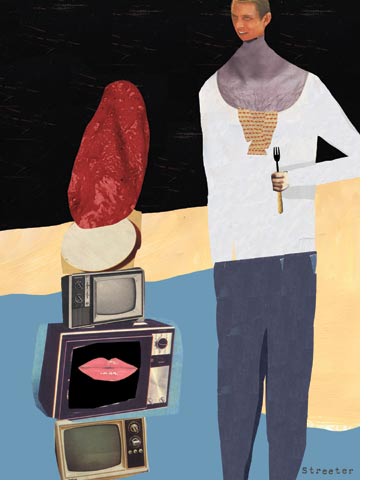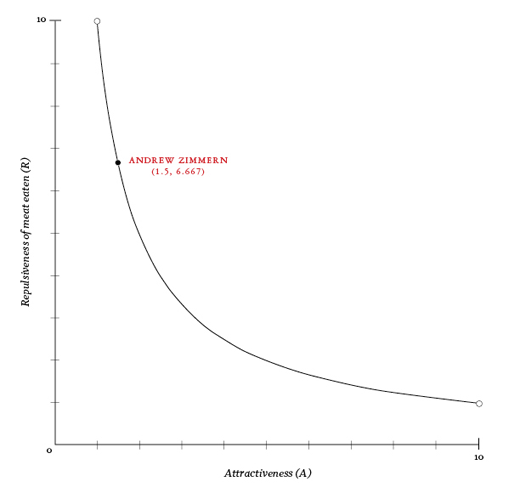Meatpaper eight
The Repulsion Will
be Televised
On why we watch men eating meat
by Chris Ying
illustration by Katherine Streeter
JULY, 2009
 A
QUARTER OF THE WAY INTO CHASING AMY, Holden
(Ben Affleck) and Banky (Jason Lee), two comic book writer-artists,
are at the train station, headed on a two-day trip to a
comics convention. On the train station floor, Banky unzips
his dufflebag and produces a fat stack of nudie mags, to
which Holden remarks, aghast: A
QUARTER OF THE WAY INTO CHASING AMY, Holden
(Ben Affleck) and Banky (Jason Lee), two comic book writer-artists,
are at the train station, headed on a two-day trip to a
comics convention. On the train station floor, Banky unzips
his dufflebag and produces a fat stack of nudie mags, to
which Holden remarks, aghast:
Oh my God, who are you? Larry Fucking
Flynt? What are you going to do with all those? ...
BANKY: Variety’s the spice of
life. I like a wide selection. Sometimes I’m in the
mood for nasty closeups. Sometimes I like ’em arty
and airbrushed. Sometimes it’s a spread brown eye kind
of night…
… and so forth. It’s a
joke about how many types of porno there are. There are many,
of course, and there are many avenues through which we procure
them.
But the infinite fetishism that the
porn industry caters to is only one manifestation of a general
media oversaturation that has also produced a tangentially
related — but probably more appropriate for this publication — phenomenon
of television programming.
Currently populating a large part of
the Travel Channel lineup are the following shows:
Anthony Bourdain: No Reservations
Bizarre Foods with Andrew Zimmern
Man v. Food
Dhani Tackles the Globe
All of these flagship shows — save
Dhani, which we’ll get to — abide by a similar
formula. Specifically, unattractive men eating unattractive
meat.1 To wit: Bourdain, a lanky, weathered poplar of a man
dines on feces-laden warthog colon in Namibia. Zimmern — squat,
bald, and dressed in budget safari — eats wallaby tail
in Australia. Adam Richman of Man v. Food travels
America locking horns with various restaurants that reward
people who can finish Brobdingnagian bowls of ramen or 7-pound
breakfast burritos. He’s sort of neolithic in appearance.2
Each show appeals to one of two distinct
forms of fascination: voyeurism or surrogacy. Voyeurism is
the same attraction that spawned reality television, shock
jockery, talk shows, rubbernecking, and raunchy porn. Surrogacy,
or vicariousness, appeals to would-be gastrotourists, who,
upon hearing their preferred travel host declare that Malaysian
torpedo soup is “hmm…
not bad,” bubble over with jealousy at the prospect of
slurping down their own steaming bowl of ox dong.3
Neither voyeurism nor surrogacy has anything
todo with our relationship to food. That relationship is
a simple one. Or rather, it was once a simple one. Food sustains
us. Food tastes good. This encourages us to continue to eat
it, survive, and maintain the species. It’s the same
with sex. Sex gives us pleasure, so we seek it out, produce
future generations of sex-seekers, and maintain the species.
And so we kill animals and ruin personal
relationships for the sake of these satisfactions. But in spite
of whatever moral objections one might have, both sex and eating
meat still fall within the realm of natural. Where food television
and pornography come into play is from a distinctly unnatural
entry point. Neither provides us with the pleasure it hints
at. They elicit hunger and lust without satiation, which it
would seem would make us hate them. Yet we continue to gobble
up both.
And as with pornography, food television
is multifarious. It’s not all still-beating cobra hearts
and crispy seahorses. Over on the Food Network —
the foil of the Travel Channel — the lineup includes
the following:
Giada at Home
Barefoot Contessa
30 Minute Meals
Paula’s Best Dishes
Easy Entertaining with Michael Chiarello
Quick Fix Meals with Robin Miller
Tyler’s Ultimate
Diners, Drive-Ins and Dives
Most of this Food Network lineup relies
equally on our attraction to spectacle and vicariousness, but
directs itself at a different audience (again, save for one
outlier in Diners, Drive-Ins and Dives). What’s
for sale on the Food Network is a more chichi lifestyle than
the gastro-adventure face stuffing marveled at or aspired to
by Travel Channel viewers. There are no dimly lit backalley
street food stands or closeups of animals in half disassembly.
What there is is soft-focus photography, impeccable set design,
well-groomed hosts, chicken, beef, pork, and fish — much
more palatable and recognizable forms of meat.
Considered in the context of the unattractive
men/unattractive meat (UM/UM) narrative, the Food
Network’s polished lineup gives us a clearer view of
the equation. There’s an inverse proportion, it seems,
between one’s level of attractiveness — or at least
TV presentability — and the attractiveness of the meat
one is required to eat onscreen. So if
A is a numerical measure of a TV host’s
physical attractiveness, let’s say, out of 10.
And R is a numerical measure of the repulsiveness of the meat
that the host must eat, also 1–10.
Then, R = 10/A.
For example: Andrew Zimmern, who probably
consumes the most unattractive meat of any TV host,
is like a 1.5 physically, and the meat he eats is a 6.667 in
repulsiveness. While Giada De Laurentiis, who eats a 1 in repulsive
food, is then a 10 (A = 1(10); A=10) in TV presentability.4
It looks something like this:

This is all just a roundabout way of saying,
the weirder-looking you are, the weirder the food you have
to eat. The two outliers I mentioned — Dhani and Diners — serve
to make the case. Dhani Jones, a dapper NFL linebacker who
designs bowties on the side, trots around from country to country
learning about and competing in various national sports. While
in country, he’ll eat the
local food. But where Bourdain and Zimmern force smiles as
they consume swallow’s nests and insect larvae, Dhani
fusses and moans when presented with unfamiliar durian or frog’s
legs. He’ll stick out his tongue for the teensiest taste
before fleeing. But he’s a football player and he’s
good looking; we don’t expect him to be eating the nasties.
And then there’s Guy Fieri, who hosts Diners,
Drive- Ins and Dives. He’s not prim and comforting
like the Barefoot Contessa, nor fratboy-ish and hunky like
Tyler Florence. He looks like an acid-washed porcupine, and
for this he travels around the country gobbling up greasyspoon
burgers and enchiladas. He’s like a 1.75 in looks,
and eats a 5.7 in gross food.
* * *
Niche marketing isn’t news, nor is
the fact that less attractive people have to perform more ridiculous
acts than hot people to get on TV. But there are ramifications
of UM/UM programming.
The fetishization of exotic foods eventually
leads to the importing of dishes and nonnative food products,
which creates a sort of disruption of cultural — and
biological — ecology. You can see it for yourself whenever
you set foot into a sushi joint in Indiana.
And long before Whole Foods starts selling
frozen turtle meat pies, there remains the fact that these
hosts are expending energy and resources marching into obscure
locales so that they might sample some local critter. From
time to time, animals are killed onscreen, and the producers
play up their host’s cavalier lack of squeamishness.
If the complaint about porn is that women are treated like
meat, then the problem with UM/UM television is that meat is
treated like meat.
Still, is there really a hierarchy of nobility
when it comes to killing and consuming animals? Does
the impoverished family that first killed and ate the horrifying,
trilobyte-looking horseshoe crab have more right to do so than
the aging TV personality who does so for a living?
In all honesty, we can’t really blame
television for overfishing, or for lousy, overpriced renditions
of street food in upscale restaurants. Nor can we blame TV
for aspiring housewives lusting after organic home gardens
and Hamptons beach houses. It’d be like blaming porn
for teen pregnancy and sexually transmitted disease. It’s
all just entertainment. And at the end of the day, food television,
like porn, is irrevocably and essentially unsatisfying. They
keep turning us on, but we keep
watching, mouths watering and agape in horror. 
Footnotes:
1. It’s of course unfair of me to categorically
declare these men to be unattractive. I mean only to say that
they’re not Adonises. They’re regular Joes: aging,
overweight, malshaped, and disproportionate
just like any of the rest of us layfolk.
2.Filling out the rest of the daily Travel
Channel schedule are shows like these:
Extreme Pig Outs
Steak Paradise: A Second Helping
Extreme Fast Food
Ice Cream Paradise
Deep-Fried Paradise
They fall into a different category than
the flagship shows, as they don’t generally have a host.
Still, they have the same contentious will-testing, gut-busting
relationship with food, and are therefore
worth mentioning.
3. I’m not sure which is foremost,
voyeurism or surrogacy. My personal interest falls into the
latter category, but from time to time I will linger on Bizarre
Foods and shout to whomever is in the room
(or to no one at all), “You’ve got to see this.
You’ve got to see this.”
4 I also like to think that there’s
a secret numerical constant that TV execs abide by when greenlighting
a show. On our 1–10 scale, that constant is 10. So, A × R
= 10. If our hypothetical TV host is a 2.1 in attractiveness,
and we’ve got him going around the world eating macaroons
and tea sandwiches, we’ve got to bring the repulsive
level of his food to 4.76 before that show gets off the ground.
Chris Ying is
an editor at McSweeney's, a former cook, and sometimes blogger.
He is also an editor of this magazine.
This article originally appeared in
Meatpaper Issue Eight.

|
